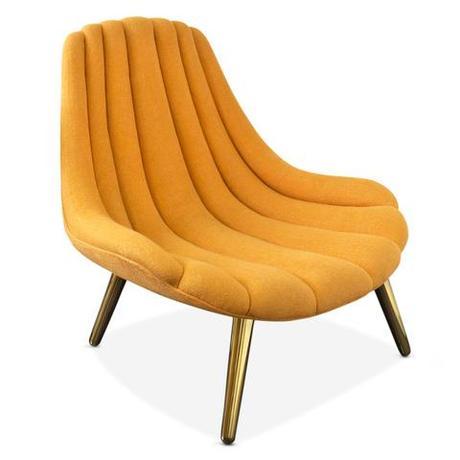
Adler’s shell-esque Brigitte Chair with brushed brass legs.
Why is the conversation about authentic design so important right now?
Every company, no matter how ersatz or unnecessary, tries to claim that they’re “authentic.” It’s the word that marketers use to try to fool the consumers’ ever-sharper BS detector. So, designers who are authentic, who have a real raison d’etre and an interesting backstory, are in a great position in today’s marketplace.
But, authentic design is fragile. Technology and the rapid increase in global sourcing are making everything accessible all the time. It’s a chaotic world, everything’s copied by everybody, authorship is becoming cloudier.
PostModernism’s message is that there’s no new tale to tell. That may be true, but I still think one has to try.
What advice would you give to creatives who are inspired by their contemporaries but want to prevent themselves from crossing the line between 'inspired by' and imitating?
It’s important to understand that the design world is a dialog, so it’s okay to be engaged with, and somewhat inspired by, contemporary design. But you must must must respect originality and draw a red line (trying to keep it topical) that you mustn’t cross. Think. Analyze. It’s okay to shop the market and discover that Emerald Green is a trend and use that color, but it’s not okay to imitate a proprietary motif or visual vocabulary of another designer.
Designers who fear having their work copied need to develop a proprietary technique, a very clear signature style that can’t be imitated. I always think about the brilliant artist Ruben Toledo, a painter/illustrator who is so gifted that he’s inimitable. He is the gold standard. If you focus on craft and have mad skills, you can’t be copied.
Conversely, if your work is simple and/or easily reproduced, you should realize that you will be copied and you should focus on having new ideas on deck. I think it’s important to be as focused on the future, on what you’re going to design, as what you’ve already done.
How do you approach design authorship in collaborations with other designers or brands?
I love collaborations. It’s always fun to play in somebody else’s sandbox, to work in a foreign technique or product category. I’ve collaborated with lots of companies—Lacoste, TOMS, Paperless Post --and I always come away with a better understanding of myself. What is my signature style, motif or technique that will ensure that the collaboration shows my hand as well as my collaborator. Collaborations help me understand who I am as a designer.
What do you want people to take away from your talk at City Modern?
I hope people will think that I’m as smart as my brainy-ass sister.
City Modern, presented by New York magazine and Dwell, celebrates the best in New York design and architecture with studio tours, panel discussions, cocktail parties, special installations and home tours. Taking place from September 27 to October 4, the events look to elevate the level of discussion and awareness about how design affects urban life. The full list of events can be seen here. Use the code DWELL20 for 20% off your ticket to Creativity and Constraint on Thursday, October 3rd.
